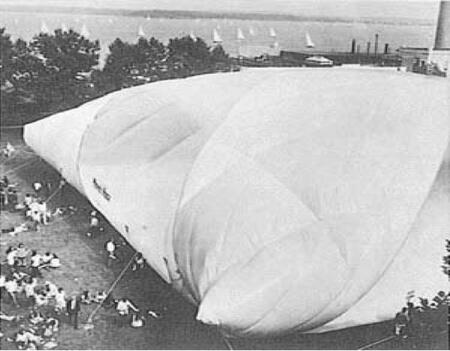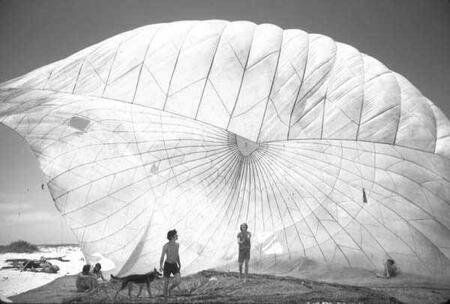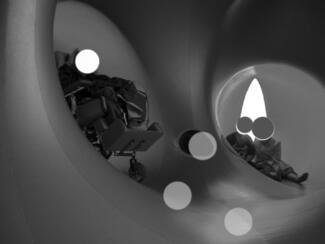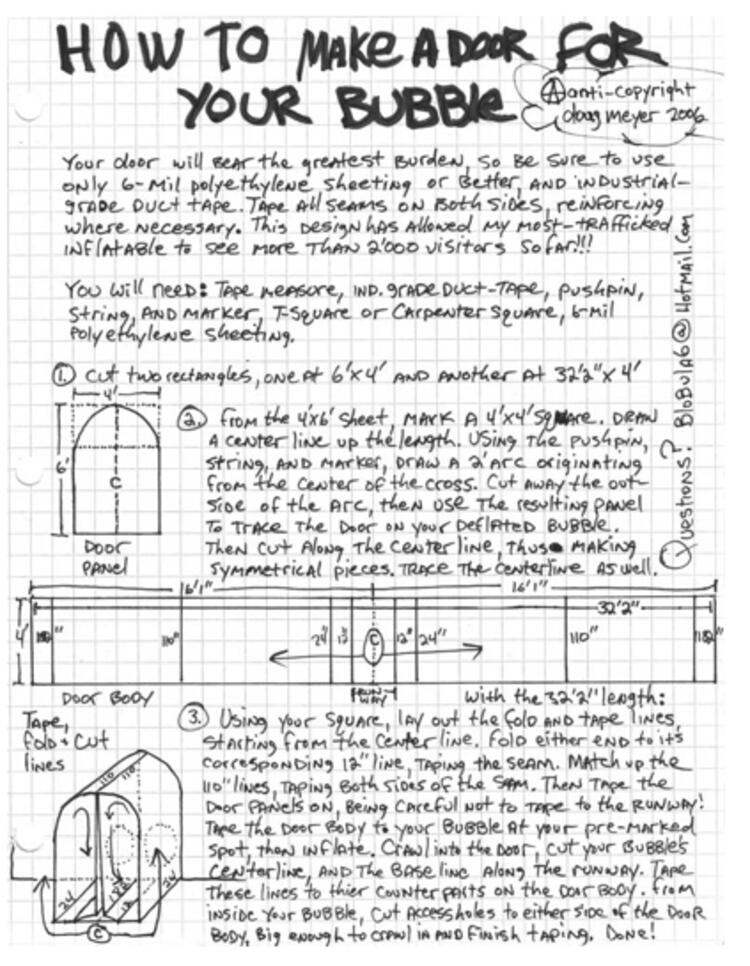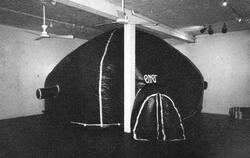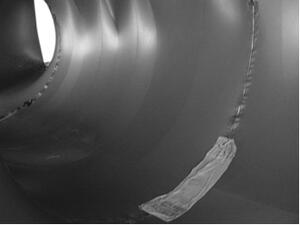This is an old revision of the document!
Table of Contents
P N E U M A T O L O G Y
[pneumatology: from pneuma, meaning air, wind, spirit, soul]
Cocky Eek - 2008
This research is written in the context of foam's multireal and real worlds:
MultiReal: 'translocal': Art in uncertain conditions
–> guerrilla art-forms – portable, robust, low-tech, recyclable media, materials and technologies that can adapt to a variety of conditions. How can we make works such as responsive environments more mobile, easy to unpack, even pocket-size (inflate as needed)? how can we make such works accessible to people without galleries and black boxes - in the middle of the desert, or a jungle, or in an urban ghetto? is this type of art and tech needed at all? (think of modular tech and architectures, cheap technological solutions for providing full-body participatory media experiences, portable and soft architectures…)
Real: 'levitating': 'off the ground' & 'out of this world'.
–> from extreme sports to extreme arts, (sometimes) defying the laws of physics. experiments in wind tunnels and zero-gravity, under-water and hanging from cliff-tops. have the arts become too tame and too self centered? has everything already been experienced? can arts still provide excitement and surprise as they used to when they were more in tune with what society experienced in everyday life? What games to we want to play in a world of mixed realities? (small performances and public interventions, expeditions and playgrounds)
while working on this research, I have scanned three design principles of gRig:
sustainability
playfulness
modularity
Lightness as a state of being
Around our contemporary environmental questions at least one thing became clear to me and that’s that out of fear, or to build on top of our guilt, we can’t create anything. So instead I rather like to slide the heavy burden of my shoulders and choose the quality of lightness. Italo Calvino underlines this quality as one of his ‘Six Memos for the Next Millennium’, in here he describes a scene from Cernavantes’ novel, leaving me with an unforgettable impression of lightness, in which Don Quixote drives his lance through the sail of a windmill and is hoisted up into the air. And I wonder can we construct our worlds from this lightness. Imagine a life more light and imagine it to be constructed more mobile, flexible, portable, organic and more related to our natural surroundings and the elements, and that we can create our homes or shelters wherever our heart is with no fixed form or any beginning and end, either spatially or in time.
The Renaissance embodied the idea of air or better ‘pneuma’ [wind, air, breath, spirit and soul] in their art of building. One of the primary goals of renaissance architects was to enhance the powers of pneuma so as to foster the art of well-being, essence, wind and ventilation were core principles of classical buildings. Pneuma was a wonderful link for establishing harmony between the human body, architecture and the cosmos, and that building was envisioned as a mediator between the inhabitant's soul and the -anima mundi-, the soul of the world. This indicates a link to contemporary environmental questions. Philibert Delorme's [French Renaissance architect 1514 -1570] describes that -the prudent architect is fully utilizing all his senses, and explains that the sense-less architect has “little nose” because he does not have the intuition of good things-, is evidence that the pneumatic architectural imagination is multi-sensorial. Renaissance notions of pneuma revealed a concern for the connectedness of person and place where architecture can refine the qualities of air to.
And in wondering if we can construct our worlds from the lightest quality surrounding us everywhere: –air- inflatable architecture comes the closests. Its thin flexible membrane, acts as a space-defining skin is able to give shape of –air- itself allowing it to be a breathing unity with its own integrity. Its close related to its surrounding its specifically bodily and tactile by nature and its portable, mobile, and playful.
Before we continue…
What kind of inflatables are we talking about...
The main quality of these inflatables is that they are alive. In such a way that it are inflatable spaces you want to be emerged with, play with, be involved with and for the rest:
- They have a scale somewhere between our second, and third skin (ps. the first skin is our own skin, the second skin our clothes, the third skin our rooms and buildings.)
- They have a nomadic character, in such a way that they are mobile or portable
- They can be seen as breathing living organisms in which their visitors can become co-structures of a space.
And who can create these kind of inflatables
We imagine that one has to be an expert to create these objects, with a few marks of the pencil, worked out laboriously at the computer. But to respect the individual who is not an expert precisely for his lack of expertise. Often people in this state of being are in a position to give free rein to change. The danger is that experts can’t do that anymore, because he’s already learned how things ought to be done, unless he gives up his own ideas and opinions. Everything that is inept, wayward, intuitive, instinctive and emotional, and emerges from ourselves- that is the expertise of the non-expert. Once the individual can go his own way, free of rules and regulations, diversity occurs, because new solutions are constantly being found.
The 1,2,3 recipe for an inflatable space
With the most common cheap plastic one can make in less then one hour an inflatable space. One can simply tape, stitch or iron the layer plastics together, make a hole and mount a table-ventilator and voila there is an inflated space. To enter the space; take a knife and make an incision. Its a quick medium to construct a space, one can practice building over and over again, every time deepening its patterns, until you know exactly how to realize spaces which works.
Some general problem domains in contemporary architecture
Juhani Pallasmaa’s described in -The Eyes of the Skin- some general problem domains in our contemporary architecture:
- The current over-emphases of intellectual and conceptual dimensions of architecture contributes to the disappearance of its physical, sensual and embodied essence.
- While computer design can give us new insights in architecture we shouldn’t forget that creative work calls aswell for bodily and mental identification.
- In general while our experience of the world is formulated by a combination of five senses, much architecture is produced under consideration of only one -the most dominated in our time – sight. The suppression of the other sensory realms has led to an impoverishment of our environment, causing a feeling of detachment and alienation.
The inhumanity of contemporary architecture and cities can be understood as the consequence of the negligence of the body and the senses, and the imbalance in our sensory system. Every touching experience in architecture is multi-sensory; qualities of space, matter and scale are measured equally by the eye, ear, nose, skin, tongue, skeleton and muscle, the way places feel, the sound and the smell of places has equal weight to way things look.
- During the design process, the architect gradually internalizes the landscape, the entire context, and the functional requirements as well as his/her conceived building; movement, balance and scale are felt unconsciously through the body as tensions in the muscular system and in the positions of the skeleton and inner organs. As the work interacts with the body of the observer, the experience mirrors the bodily (proprioceptive) sensations of the maker. Consequently, architecture is communication from the body of the architect directly to the body of the person who encounters the work.
- Modern architectural theory and critique have a strong tendency to regard space as an immaterial object delineated by material surfaces, instead of understanding space in terms of dynamic interactions and interrelations.
The experience of home is structured by distinct activities – cooking, eating, socializing, reading, storing, sleeping, intimate acts- not by visual impacts. Architecture initiates, directs and organizes behavior and movements. Consequently basic architecture experiences have a verb form rather than being nouns. Authentic architectural experiences consist then, for instance, of approaching or confronting a building, rather than the formal apprehension of a facade, of the act of entering and not simple the visual design of the door; of looking in or out through a window, rather than the window itself as a material object.
[reference to :There is a Timeless Way of Building- patterns of events]
There is a Timeless Way of Building
Pattern_language can be a tool for finite combinatory systems which allow us to create an infinite variety of unique combinations, appropriate to different circumstances, at will. Before I’ll come to patterns specified for inflatable structures, which can be useful for anyone interested in building ‘living inflatable structures’. First I like to summarize Alexander’s -Pattern Language-. This -Pattern Language- had its influence not only in architecture but as well on programming language design, software engineering and other design methodology in computer science, even The Wiki was based on his design patterns.
‘There is one timeless way of building. It is a thousand years old, and the same today as it has ever been. The great traditional buildings of the past, the villages and tents and temples in which man feels at home, have always been made by people who were very close to the center of this way. It is not possible to make great buildings, or great towns, beautiful places, places where you feel yourself, places where you feel alive, except by following this way. And, as you will see, this way will lead anyone who looks for it to buildings which are themselves as ancient in their form, as the trees and hills, and as our faces are.’ [Christopher Alexander]
Being alive
Places which have the quality of being alive, invite this quality to come to life in us. And when we have this quality in us, we tend to make it come to life in towns and buildings which we help to build. It is a self-supporting, self-maintaining, generating quality. It is the quality of life. And we must seek it, for our own sakes, in our own surroundings, simply in order that we can ourselves become alive.
Patterns of events
Those of us who are concerned with buildings tend to forget to easily that all the life and soul of a place, all of our experiences there, depend not simply on the physical environment, but on the patterns of events which we experience there. These patterns of events which create the character of a place are not necessarily human events.
Compare the power and importance of these events with the other purely geometrical aspects of the environment, which architects concern themselves with.The life of a house, or a town, is not given to it directly, by the shape of its buildings, or by the ornament and plan- it is given to them but by the quality of events and situations we encounter there. A building or a town is given its character, essentially, by those events which keep on happening there most often.
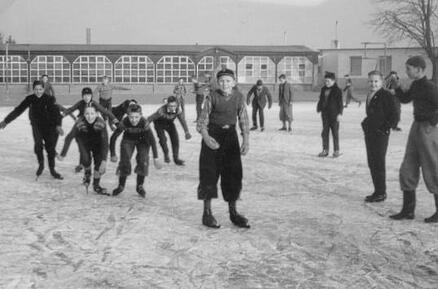
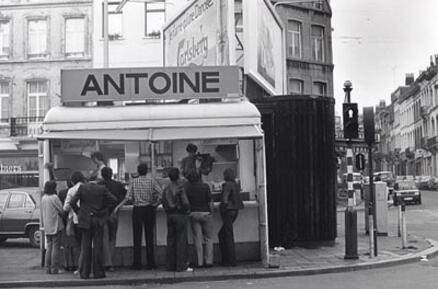
One can focus on the ‘pure aesthetics’ of a place, or on its dynamics Famous Belgium fried potato stand: it is mostly not aesthetics an sich
what brings people together.
The world does have a structure, just because these patterns of events which repeat themselves are always anchored in the space. The action and the space are indivisible. The specific patterns out of which a building or a town is made may be alive or dead. To the extent they are alive, they let our inner forces loose, and set us free; but when they are dead they keep us locked in inner conflict.
“The sunshine shining on the windowsill, the wind blowing in the grass are events too-they effect us just as much as social events. A field of grass is given its character, essentially, by those events which happen over and over again- millions upon millions of times. The germination of the grass seed, the blowing wind, the flowering of the grass, the movement of the worms, the hatching of the insects…”
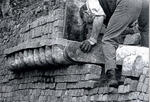 The aim in contemporary architecture is often its end result (the building itself). But when natural processes are one's aim and not their end results, one can no longer speak of an aesthetic evaluation, because all that does is enable one to form an opinion about concrete finished products. 'Beauty' [in a natural process] disappears, making way for completely unanticipated, new 'aesthetic' values. Beauty is perishable. Everything is and is always in motion.
-Louis le Roy-
The aim in contemporary architecture is often its end result (the building itself). But when natural processes are one's aim and not their end results, one can no longer speak of an aesthetic evaluation, because all that does is enable one to form an opinion about concrete finished products. 'Beauty' [in a natural process] disappears, making way for completely unanticipated, new 'aesthetic' values. Beauty is perishable. Everything is and is always in motion.
-Louis le Roy-
How does it feel
Imagine someone who proposes that modular aluminium wall panels are of great importance in the construction of houses. Simply ask him how he feels in rooms build out of them. He will be able to do dozens of critical experiments which “prove” that they are better, cleaner, healthier, lighter…but the one thing he will not be able to do, if he is honest with himself, is to claim that the presence of modular panels is a distinguishing feature of the places in which he feels good. His actual feeling is direct, and unequivocal. It is not the same as asking someone his opinion, someones taste or what a person thinks of an idea. In short, the scientific accuracy of the patterns can only come from direct assessment of people’s feelings, not from arguments or discussions.
Each pattern should be a source of life, a generative, self-sustaining pattern, and be worth copying. By defining patterns we must rely more on our feelings than intellect. When we feel the wholeness of the system it feels good to us. By contrast, patterns made from thought, without feeling, lack empirical reality entirely. Some designs from architects may excite our intellect, or our imagination; but when we ask ourselves how we shall feel in a place which is really built like this we know that it will not make us feel wonderful. It comes about because our feelings always deal with the totality of any system. If there are hidden forces, hidden conflicts, lurking in a pattern, we can feel them there. And when a pattern feels good to us, it is because it is a genuinely wholesome thing, and we know that there are no hidden forces lurking there.
The process of making things
If we compare the buildings of today with former times, is that the last one has much more variety, and more detail: there are more internal differences among the parts; they are marked by greater differentiation. there are rooms of different sizes, doors of different widths, columns of different thickness according to their place in the building, ornaments of different kinds in different places, gradients of window size from floor to floor.
The character arises of the old buildings is not because of the history, or because the process which built them were so primitive. These buildings have this character because they are so deep, because they were made by a process which allowed each part to be entirely one with its surroundings, in which there is no ego left, only the gentle persuation of the necessities.

Local Symmetries, Organic, small-scale symmetry versus an average dutch house in a average vinex council estate
On modularity
The idea that a building can-and ought- to be made of modular units is one of the most pervasive assumptions of twentieth-century architecture. Nature is never modular. Nature is full of almost similar units (waves, raindrops, blades of grass-) but though the units of one kind are all alike in their broad structure, no two are ever alike in detail.
1. the same broad features keep recurring over and over again. 2. in their detail appearance these broad features are never twice the same.
On the one hand all oak trees have the same overall shape, the same thickened twisted trunk, the same crinkled bark, the same shaped leaves, the proportions of limbs to branches of twigs. On the other hand, no two trees are quite the same. The exact combination of height and width and curvature never repeats itself; we cannot even find two leaves which are the same.
modularity is just a concept.
The quality of places is never twice the same, because it always takes its shape from the particular place in which it occurs. Each part is slightly different, according to its position in the whole. Each branch of a tree has a slightly different shape, according to its position in the tree. Each leaf on the branch is given its detailed form by its position on the branch.

1.[Uit: L. Carl Brown, From Madina to Metropolis. Princeton, 1973] de stad Tunis
Modern governments in Turkey have build next to the traditional cities, new districts with a total different character: lang straight boulevards and a regular pattern of cross-streets.
2. [Uit: Metin Sözen, Diyarbakir'de Türk mimarisi. Istanbul, 1971] The same contrast is clearly seen on this old birds-eye-viewpicture of Diyarbakir, Turkey
Differentiating space
Within this process, every individual act of building is a process in which space gets differentiated. It is not a process of addition, in which pre-formed parts are combined to create a whole: but a process of unfolding, like the evolution of an embryo, in which the whole precedes in parts, and actually gives birth to them, by splitting (so becoming different in the process of growth or development)
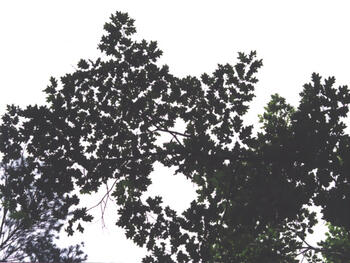
Only a process of differentiation, because it defines the parts within the whole, can generate a natural thing; because this kind of process can shape parts individually, according to their position in the whole.
Patterns have a certain order in a design, so you have to understand which features are dominant, and which are secondary, and so the sequence of the patterns will become clear. It is not a sequence of putting parts together, but a whole, which expands, crinkles, differentiates itself. When the order of the patterns are correct, the differentiating process allows the design to unfold as smoothly as an opening flower.
Get rid of the ideas which come into your mind. Get rid of the pictures you have seen in magazines. Insist on the pattern, and nothing else. The pattern and the real situation, together, will create the proper form, within your mind, without you trying to do it, if you allow it to happen. There is no reason to be afraid of giving up your control over the design. If the patterns make sense, you do not need to control the design.
As the design unfolds, and new patterns our brought into play, the entire design has to shift and resettle itself in your mind with every new pattern. Each new pattern in the sequence transforms the whole design created by the previous patterns- it transforms it as a whole, it shakes it up, and realigns it. This can only happen if the design is represented in an utterly fluid medium; it cannot happen in any medium where there is the slightest resistance to change. A drawing, even a rough drawing, can be very rigid-it embodies a commitment to details of arrangement far beyond what the design itself actually calls while it is in an embryonic state. The only medium which is truly fluid, which allows the design to grow and change as new patterns enter it, is the mind.
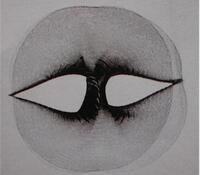
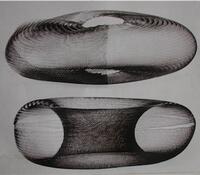
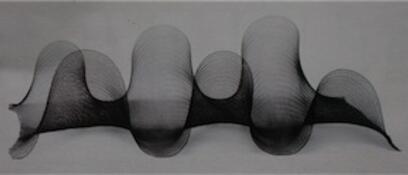
Maria blaisse, a dutch designer/researcher in the field of flexible materials and worked among with o.a. Issey Miyake, never makes a drawing of how she wants design to be. The objects above are created by focusing purely on the qualities of a flat woven plane out of which 3d forms were unfolded. “In one form many qualities and movements are captured, by interfering with them you can release these energies your way. Once you start working like this you can capture the movements that you recognize and be as creative and efficient as nature.Then your form contains a vibrant energy.”
The building process
It is essential that ‘a builder’ works only from rough drawings: and that he carry out the detailed patterns from the drawings according to the processes given by the pattern language in his mind. This is common place in nature. When the spider builds its web, the process is standardized; but the parts which are created are all different. Each web is beautiful, unique, perfectly adapted to its situation. Yet it is created by a standard process; and there is just one process. It is very simple. Yet this simple process interacts in an infinite variety of ways with different circumstances to produce different particular webs.
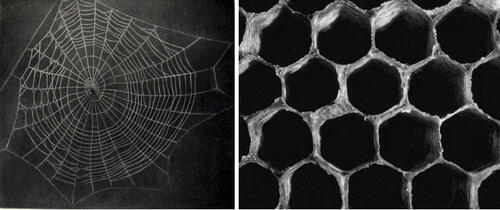
generated spases: spider web, close up of a honeycomb
Or for instance waves; the actual concrete waves themselves are always different. This happens because the patterns interact differently at every spot. They interact differently with one another. And they interact differently with the details of their surroundings. So every actual wave is different, at the same time that all its patterns are the same precisely as the patterns in the other waves.
In such a system there is endless variety; and yet at the same time there is endless sameness. No wonder we can watch the waves for hours; no wonder that a blade of grass is still fascinating, even after we have seen a million of them. In all those sameness, we never feel oppressed by sameness.
When a group of people try to do something together
When a group try do do something together, they usually fail, because their assumptions are different at every stage. But if they come from language the assumptions are almost completely explicit from the start. Once they agree about a language, the actual emergence of the form is simple and fluid. In the building stage the group uses the site “out here in front of them” as the medium in which the design takes its shape. People walk around, wave their arms, gradually build up a common picture of the building as it takes it shape –and all still without making a drawing. The process of shaping a building, simply by walking in and out, waving their arms, thinking together, placing stakes in the ground, will always touch people deeply, they will feel alive
About beauty
How was it possible that any simple farmer could make a house or a barn, a thousand times more beautiful than all the struggling architects of the last fifty years would do. Well they simply copying the other barns in their neighbourhood which function.

This is a very typical farmhouse in Zeeland an area in the southwest of Holland. These farmhouses are completely demountable (a technique blown over from the Vikings) so one could take it apart, transport it over Zeeland’s rich waters and settle one island further if you want. The roof is from straw, which grows in that area, it gives a lot of comfort: it keeps warm in the winter and stays cool in the summer. People made their own paint from fresh oxblood en lijnolie so all the barns had this typical ox-red color in their interiors, and outside they paint their barns with black tar, with white frames around its doors, so one could find the opening when coming home drunk in the dark. Though still one had to watch out; to enter one had to make a high step; this was made to prevent the waters coming in at high tide. All its patterns were worked out well over time for that specific area, so it was worth to copy the patterns and these rooted farmhouses can be seen all over Zeeland.
The multiplicity of living patterns
The more living patterns there are in a building and its environment -the more it comes to life as an entirety, the more it glows, the more it has this self-maintaining fire, which is the quality without a name.The quality without a name occurs not when an isolated pattern occurs, but when an entire system of patterns, interdependent, at many levels, is all stable and alive.
A building in which all the patterns are alive has no disturbing forces in it. The people are relaxed; the plants are comfortable; the animals pursue their natural paths; the forces of erosion are in balance with the natural process of repair which the configuration of the building encourages; the forces of gravity are in balance with the configuration of the beams and vaults, and columns, and the blowing of the wind; the rainwater flows naturally in such a way that it helps to grow the plants which are in balance with themselves to grow in between the cracks in the paving stones, the beauty of the entrance, the smell of the roses in the evening in the outdoor room.

“When I am working on a problem, I never think about beauty but when I have finished, if the solution is not beautiful,
I know it is wrong.” –Buckminster Fuller–
An Inflatable Pattern Language
Architects of Air [UK] are creating every year a new inflatable structure where people can be moved to a sense of wonder at the phenomenon of light it aims to bring a visual surprise and excitement into the everyday environment. There structures are working quite well and I
I will describe their patterns they have deepened over the years quite distinct.
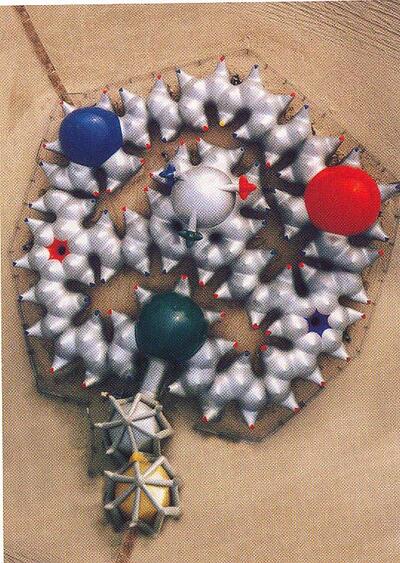
Architects’s of Air Luminarium, photographed in Patrick de Koning’s kite IJmuiden Beach – 2001
Co-structors
Even when an inflatable has been in situ for several weeks there is still maintained the element of surprise for those traveling to work, going shopping or to school. People walking by are drawn to discover what is within. They can see the movement of the structure caused by people walking around inside, they can see the outlines of visitors’ bodies as they lie back against the sides, they can see the regular inflation and deflation of the airlock as it swallows and disgorges groups of visitors. Once inside, visitors can enjoy the unique nature of the structure. No two visits to a structure are the same, the atmosphere inside alters according to changing weather, the changing light and the experience is also very much affected by the other visitors inside and the way that they relate to the Luminarium. The visitor’s are co-structures of the space.
Natural coloured/filtered light coming in
The experience of light and colour inside is purely created by the daylight shining through the translucent parts of colored plastic - a plastic made especially for Architects of Air-. Luminescent light will add special life.
The raindrops on the outside can be experienced on the inside through its semitransparent plastics.
One can place an inflatable under a tree to create filtered light. Light filtering through a leafy tree is very pleasant - it lends excitement, cheerfulness, gaiety; and we know that areas of uniform lighting create dull, uninteresting spaces.
An object which has small scale patterns of light dancing on it is sensually pleasing, and stimulates us biologically. Some filmmakers claim the play of light upon the retina is naturally sensuous, all by itself.
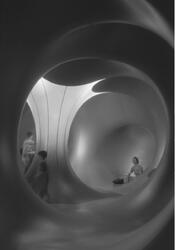
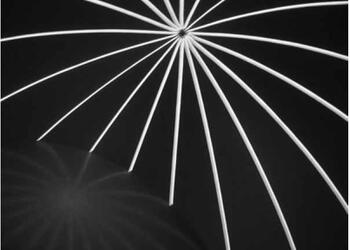
Daylight grading down a column, The ceiling with blue luminescent stripes of 1,5 cm gives a strong luminescent effect.
Frank Lloyd Wright describes his use of the canvas roof, in the very early structures at Taliesin West:
. . the Taliesin Fellowship (is a) desert camp on a great Arizona mesa which the boys, together with myself, are now building to work and live in during the winter-time. Many of the building units have canvas tops carried by red-wood framing resting on massive stone walls made by placing the flat desert stones into wood boxes and throwing in stones and concrete behind them. Most of the canvas frames may be opened or kept closed. . . . The canvas overhead being translucent,
there is a very beautiful light to live and work in; I have experienced nothing like it elsewhere except in Japan somewhat, in their houses with sliding paper walls or “shoji.” (The Future of Architecture, London: The Architectural Press, 1953 pp. 255-56.)
Sitting alcoves
Disorienting and comforting
The space is simultaneously disorienting because of its libarynth set up and at the same time its soft topological inner space provides a comfortable feeling.
Entrance transition
The transition space before entering the main-entrance helps to slowly come to a different mindset. At the main entrance were two columns inflated on high pressure. Most people touched these columns before entering inside and entering the first, where one could take of their shoes, was a space still open to the outside air so there wasn’t a certain abruptness about suddenly stepping in, from the outside, directly to the inside…it is subtle, but enough to inhibit you. This is psychologically half way between indoors and outdoors, and makes is much easier, more simple to take each of the smaller steps that brings you into the inflatable.
Ceiling height variety
The vaults helps to create the ceiling height variety of the different spaces inside. Low spaces are more intimate and high more formal.
Columns
Columns are influencing the space around them, and then we are talking about a circle shaped area with a radius of about 1,5 meter. Column preferably should be a thick ones.
Different paths to walk
When a space has crossing paths from different 'rooms', it helps to generate a sense of habit there, so it becomes a pleasant customary place to be. One can resolve the forces for themselves.
The skin
Our contact with the world takes place at the boundary line of the self through specialized parts of our enveloping membrane. There is a very special beauty about inflatables. It has a softness, a suppleness, which is in harmony with wind and light and sun. It will touch all the elements more nearly than it can when it is made only with hard conventional materials. It can be used to filter very bright hot sunlight or to make total darkness, protect from wind meanwhile showing a little breeze and it can hold off a drizzle.
Portability
They are build to fold away, being carried and are easily to set up. in combination with tensile structures [with pulling forces – in the construction] one can make strong, lightweight and portable structures.
The more problematic patterns
- To me the space is too blobby round.
[When we look at the human-power working on a space, we see that a social space should have a form in between two contrary shapes (the strong crystal/square shapes and the biological wombs spaces). It works the best on us if a space is about rectangular. Even the strange geometry of a dome can be experienced as a strait-jacket. An vault is an idol roof for a social space. An ideal vault for an inhabitant space starts at an hight of 180-210 cm and rizes 13 till 20 percent of the smallest diameter of a space.]
- It became very hot when its warm, or freezing when its cold.
- The PVC material which is especially smell-wise very dominant in its odeur and very toxic in its nature, so not io beautiful in the end.
- For me the fixed choice of colors was very dominant; it was impossible to put you own fantasy to the color, a blue was so blue, that it only gave its impact on you. In the areas where colors started to mingle were more interesting.
- People inside became very sleepy after a while; it´s a passive space aswell the ongoing ambient music makes you murf and maybe it was as well the dose or flow of oxygen which slows you down.
Design considerations for inflatable structures
After Coming across the problematic patterns of the architects of Airs’s Luminarium. I thought its worthwhile to acknowledge the most common obstacles one comes across in inflatable structures anyhow. No solutions will be given to any design problem, but some suggestions will be given so now and then… When we are able to surpass these obstacles, these structures will be more stable and alive.
Temperature regulation
adapt/prepare for local weather circumstances: A single skin inflatable can become instant hot when the sun shines, or freezing cold when not. For temperature regulation one can think of a double skin; where walls of air will have an isolation function and at the same time an acoustics isolation function. In this way the walls can as well become a part of the construction. The climate in these zones can be influenced artificially. Heat- There is always a temperature differential - it will generally be warmer inside an inflatable than outside. A temperature of 27oC/ 80oF outside could mean that inside may be uncomfortable. When it is this warm one can use water misters to spray the air. Additional strategies to deal with heat is to place the inflatable near shade if possible or cooling by air-conditioning. Or making use of materials which reflects the sunlight.
Cold – One can use portable heaters and a layer of polyurethane foam beneath the structure.
Or to find some sheltering of bushes for the inflatable on the north side to keep warm.
\\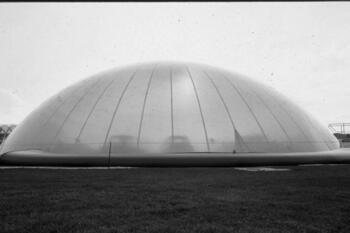
Festo’s Airquarium holds a water-filled torus serving as a foundation and at the same time a water-exchanger for cooling and heating, (water cools much better then air, it can store the coldness better) and it holds a weather station thermostat-control. Festo has as well designed an ‘Exhibition Hall’ exploring the field of air-conditioning. In addition to the natural ventilation through the two doors, an air conditioning system is provided. The conditioned air is distributed via 2 textile supply air-supply ducts, suspended from the ceiling. Gravel fill under the grating is used as heat storage; light -colored Rhine gravel keeps infrared absorption to a minimum. Radiators in the air space between grating and gravel bed heat the hall in winter. In summer a cooling system is available to cool the hall. The double layer walls of the exhibition hall promise improved thermal insulation compared with conventional membranes. Soft Shells, Hans-Joachim Schock, p102-105]
Air ventilation
The focus of an inflated bubble is to make it airtight so it preserves its air preciously, but make sure there is an air-circulation going on inside the inflatable. [see as well Festo’s Exhibition Hall at temperature]
Hybrid Structures can get us further…

There is a big potential of carbon fibers. (or bamboo, which is naturally divided into closed compartments that prevent it from buckling) which can leads to a very light structure.
Buckminster Fuller bedacht tensegrity: een samentrekking van tension en integrity. De essenty van alle tensegrity constructie is, dat alle trekbelasting wordt opgenomen door een enkel continu element, bijvoorbeeld door een kabel, terwijl afzonderlijke korte dikke elementen de drukrachten voor hun rekening nemen. Het opvangen van trekbelasting heeft het voordeel ten opzichte van druk dat er minder materiaal voor nodig is. trek leidt tot rank en dun. Met kabels en stangen en met een membraan of doek (tent, ballon) zijn goede constructies temaken.
Strings and fabrics are basic structuring materials which exclusively absorb tension stress, fabric is able to do this in more directions. To distribute forces they have an entire surface at their disposal instead of just one line. therefor they are ideal for creating light objects.
There are a number of basic rules for supporting a maximum load with a minimum of material. To start with , a structure needs as many natural load paths as possible, with a minimum of diversions or dead ends so the topology of load paths should be optimal. Next if possible, try to replace beams that are under pressure with systems in wich tension forces are predominant. Think for instance, of diagonal in frames and of tensegrity structures, as devised by buck Minster Fuller. (flying lightness)
Mostly the edges of an fabric's seams are the weakest points. Those are the parts which first starts to tear or leak
How to evacuate
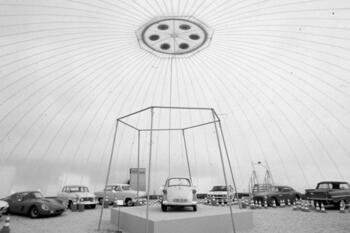
In Festo’s Airquarium they build a steel frame, which can keep up the cloth in case that an evacuation procedure will be initiated in the event of: winds exceeding 40km/hour, power failure, structure allure or others. Make sure there are divers zips positioned throughout the structures that can be opened in case of an emergency. On can as well think of a tunnel made out of steel frame keeping up the cloth and leading you to an exit.
Whole system thinking
One of the classical mistakes often made with a new material, is to leave the original structure and functional design largely unchanged. but with the choice of new materials, structural concepts and production techniques can be an intended improvement of the performance of the system as a whole. By means of integral redesign, in which balanced integration and segregation of all functions are key factors can improve all aspects. So for instance you when creating a space focused on acoustic isolation, temperature regulation, and portability, and which doesn’t need any more inflation once its standing, then try to see if its possible to make one whole integrated design. Be aware that in a design all patterns are alive because if one pattern is dead it will spill over into the others. Other ways to think ‘whole’:
- Think about creating micro-climates
- Think in bio-life-cycles
- Think about integrated responsive systems
- Think of the “system” of a dynamic and a complex whole, which information flows between the different elements that compose the system
- Think of it as an organism situated within an environment which information flows from and to the surrounding environment via semi-permeable membranes.
- Think 3 generations ahead
Buckminster Fuller thought of the whole context when designing.
How to design an airlock
Airlocks are required at entrances to prevent loss of internal air-pressure. Examples of entrances are a revolving door, airlock portals or just zippers or Velcro. Zippers (and there also exist waterproof zippers) are easier to operate than Velcro.
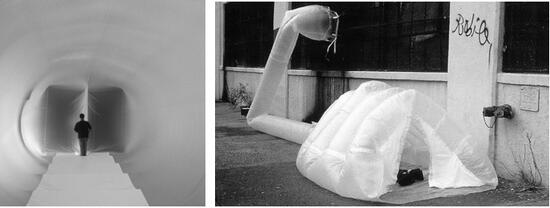
-An entrance via the two sheets pressed together because of the air-pressure inside.
-When using a double wall construction; one doesn't need a proper door.
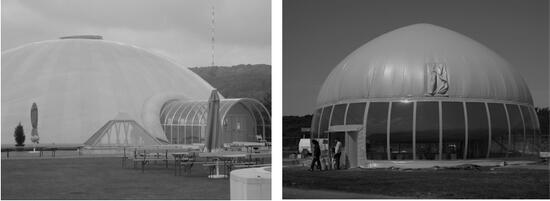
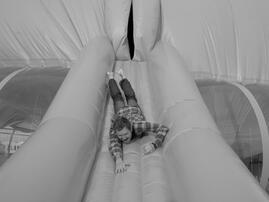
-Festo’s airquariums airlock; a rigid tunnel-construction with on each side a door.
-Theo Botschuiver's space-auditorium using a revolving-door
-Theo Botschuiver's emergency exit in his space-auditorium: his‘vagina-glide'
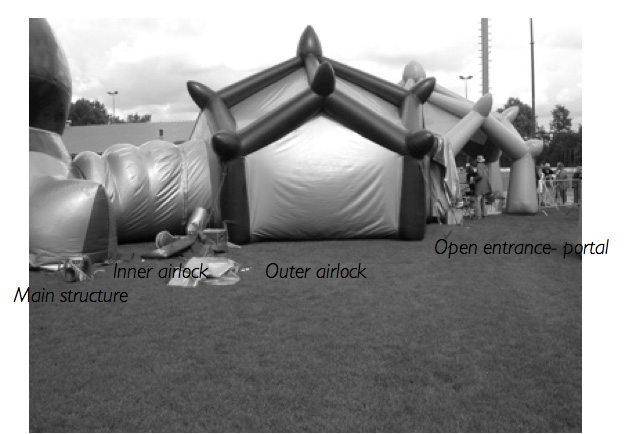
Architects of air’s airlock; one entrances through an open entrance-portal (right)
Where you can take of your shoes, then via a door flap one enters the first outer airlock (middel), both the entranceportal and the outer airlock are strechted up by high pressure poles, after the outer airlock via another flap one enters the inner airlock (tunnel left), and via a last doorflap finally in the mainstructure (on the far left). An assistent ensurse that the outer doorflaps are closed before the inner doorflap is opened.
How to extend inflatables in modular parts
One way is to connect parts by short round corridor pipes as a space to extend and connect the pipes through waterproof zips
Fingers and ventialators

One can prevent children sticking their fingers in the ventilator by stitching a net
in the pipe-hole.
Implotions
Some inflatable pumps can implode
(Transparent) inflatables, like glass, can evoke destructive/aggressive behavior
The analogy of blowing bubbles

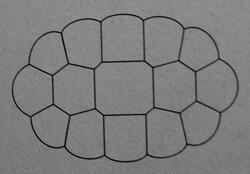
Stacking spheres and making them share their skins lead to the minimum energy structure of foam. Foam consists of shapes with an average of 14 faces, a minimum energy structure in the sense that stress is optimally divided in spaces. Various cells with different diameters can be build together in a stable way. If we combine, for instance, three articulated cells we obtain a multi-dome construction in which the dividing walls, possibly reduced to pillars, become structural elements loaded with pure tension. [from flying lightness]
How does the floor feel under your feet
A single layered material sheet, laying on grass gives a very pleasurable feeling to your feet.
How to get the air in
air_in_inflatables.jp
One can try to make a 'symbiont' - to use a buildings HVAC (Heating, Ventilation or Air Conditioning) system. The warm air leaving the building inflates and heats the membrane structure. [see 2e picture of how to design an airlock] or any other infrastructure that the inflatable is attached to as a source of power for inflation - instead of just plugging the blower into electricity, to inflate (parts of) the structure - in that way it is more energy efficient, but also the inflatable will change shape depending on the activity inside the building…
Or even is it possible to get the natural wind streams direct inside the inflatables.
Windy cities with high buildings or seasides can develop spots with a constant flow of high wind-speeds.
Or work with green energy sources like: windmills, wind towers, scoops, solar power, kite set-ups etc. to generate energy for inflating. Or one can make use of self-inflating techniques where you wouldn't have to use electricity to inflate something.
What kind of materials you wanna use
The skin maybe the biggest organ in architecture. Its that thin fleece which keeps the integrity of a space whole. You can design different kinds of qualities for the skin: a skin which is semipermeable, which determines what is in and what is out…. a skin who has a close relation with its surrounding which can adapt; get pimpels for protection against the cold or from excitement. It can change color: blue from being cold, red from being ashame or excitement, it can dry out get brown, get pocky from being polluted it can sweat, it has eyes and it can breath, and it decays nicely. One can make it responsive by integration of subtle technologies, one can look for qualities like scales in translucency or elasticity. Some materials have to be highfrequency sealed other can be glued or just stitched. Other qualities are; non static, biodegradable, lightweight, strong, resistant to tearing, self-repairing. Toxic materials aren’t that beautiful: pvc's are very toxic like many fire-retardant materials based upon PBDE or BFR are extremely toxic, which have proven to cause development disturbances. When you’re self working with it, you can feel yourself it isn't healthy. There are plastics which contain no toxics. When a material says free of….it doesn’t mean that the replacements can be worse. So just define whats in it and if its toxic or not. (can you eat it or not). One can look into microfibers, non-wovens, woven vecram (used in the space industry), coated fabrics etc.
- Preferable look for local materials in a circle of 100 meter, or 1km around you. What kind of materials can you find in your own area, instead of directly looking for chinese markets where they have the cool stuff…and has to travel from afar.
- material_library's: nowadays there are many material libraries like
- Materio in Enschede;
- the Design Academy in Eindhoven,
- Materialsense,
- Materialconnexion
- Materia
Althought you can visit them online a physical visit is worthwhile when it comes down to materials because you simply want to touch them.
- Fairs:
- The composite fair in France (for composite sticks),
- TechnoTextile, every 2 years in Frankfurt,
- Macropak te Utrecht,
- cradle_to_cradle fair in Frankfurt 12-18 november 2008,
with only products which are nutrients for the bio or technical cycle. Cradle to Cradle is aswell connected to materialconnexion] http://www.materialconnexion.com/cradle2cradle.asp
Dominant smells
Many inflatables have a very dominant smell inside. Especially the one which use
pvc’s . There are aswell many plastics which adapts the smell in them, depending on what happened, they can leave you with a smell of fried oilballs, sigarettsmoke, or the smell of a chinees restaurant. And there exists odeur repelling fabrics But nylons or ETFTE are smelling–less. Some PET and silicon fabrics have aroma barrier properties. On the contrary one can think of spreading specific odeurs in the space via the ventilators.
Anchoring
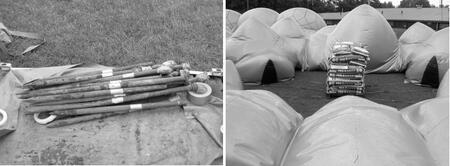
-Architects of air’s anchorage by pins 800mm x 25mm diameter.
-Ballast anchorage usually takes the form of sandbags or concrete blocks in units of 125k, to come to a total weight from 5 - 12 tons
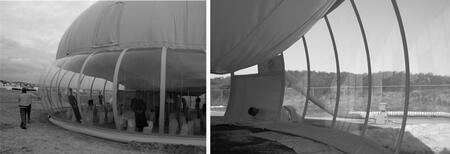
Theo Botschuiver's Space audtorium was anchored by digging a flap in the local sand of the beach[see aswell Festo’s Airquarium at Temperature]
Static materials
Some materials are so static; that all your hair will rise or even one can get electic shocks when touching the fabric.
How to diffuse the daylight and how to get light in the dark

The spaces can leave the spectator disorientated, seemingly floating in boundless space or tumbling into unfathomable depths just by the play of light. The experience of light and colour inside inflatables can for instance purely be createdy by daylight shining through semi- translucent coloured materials - the atmosphere inside alters according to changing weather, rainfall, clouds, sun, shade of moving trees etc.
Accecesible for less mobile people
The structures have been of value in attracting sectors of the community that are often excluded and have traditionally been difficult to involve, in particular the elderly and people with mobility difficulties.
It-sustains-itself
A good inflatable design can be so congruent with peoples feelings that it sustains itself- when it gets dirty or worn people take care of it themselves, because the pattern is deeply connected to their own experience. From outside, it seems as though the inflatable maintains itself almost as if by magic.
It is the self-sustaining character the living inflatable has, which is the result of making something with real care.
Because people enjoy being there, they look after it and even when no one else is there, you can “feel” the presence of life there, because you can sense that people are taking care of it.
Getting old nicely
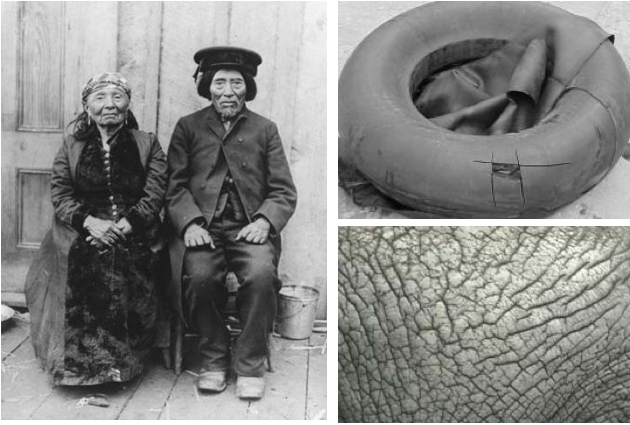
The character of nature can’t arise without the presence and the consiousness of death.
But before they die, make sure you choose materials which decay nicely. Modern modern sculptures or architects often choose material which decay awfull.
Build to die
The character of nature is fluid, rough, irregular, but it will not be true, unless it is made in the knowledge that it is going to die. No matter how much the person who makes a building is able to understand the rhythm of regularity, it will mean noting so long as he creates it with the idea that it must be preserved because it is so precious. If you want to preserve a building, you will try to make it in materials which last forever. You will try to make sure that this creation can be preserved intact, in just its present state, forever. Canvas must be ruled out because it has to be replaced; tiles must be so hard that they will not crack, and set in concrete, so that they cannot move, and so the weed will not grow up to split the paving; But to reach the quality without a name, a building must be made, at least in part, of those materials which age and crumble. Soft tile and brick, soft plaster, fading caots of paint, canvas which has been bleached a little and torn by wind.
Cradle to Cradle
Conventional environmentalists focus on what not to do, here it can use aswell some transformation: instead of presention an inspiring and exiciting vision of change. Environmental destruction is a complex system in its own right – widespread , with deeper causes that are difficultt to see and understand. Like our ansestor, we may react automatically with terror and guilt and we may look for ways to purge ourselves ( get rid of the unwanted feeling) which the eco-efficient movement provides in abundance, to focus on what not to do by minimizing, avoiding, reducing, and sacrificing. Humans are condemmed as the one species on the planet guilty of burdening it beyond what it can withstand; as such, we must shrink our presence, our systems, our activities, and even our population so as to become almost invisible. But what about ourselves, we are part of human nature to and if we don’t usse our creativity we’ll die. To be less bad is to accept things as they are, to believe that poorly designed, dishonorable, destructive systems are the best humans can do. From our perspective, this is a depressing vision of our species role in the world. These kind of guild we are carrying on our shoulders and especially the fear it brings with it are destroying your creativity, and it is especially this creativity you need to come up with intelligent solutions. So what about an entirely different model
Preferably is to work with biodegradable materials so after use one can feed it in the form of nutrients to the ground or to use materials which can be upcycled in a techinal cycle the cradle_to_cradle concept. One can use materials which after use can break it down in the bio cycles (like plastics made from mais), or upcycle it in a technical cycle.
But it isn't always that simple; for instance one wants to use bioplastic, and the bioplastic as it is biodegradable, but when you look further and you find out that it is grown as a monoculture and erosing the grounds and pollutes the air massively by its production and which has to travel from far, then one can wonder if this is that beautiful ‘bio-degradable’ material we want.
But you don’t have to be perfect right now as long there is a direction and all these materials are not all available now,
but you can set your goal for 20 years, just define where you wanna go.
Discussion
- As I've mentioned in the context I have scanned via the inflatables three design principles and I like to come back to them a bit
- sustainability We all now that this is quite complex matter and I wonder if sustainability is really a word that can empower us… The word itself is putting a heavy load on our shoulders. It can paralyze us, or pushes our guild buttons; we must shrink our presence, our systems, our activities ans so on. So it blocks our creativity. But we are part of nature to! So maybe what empowers us more is for instance to think in bio-life-cycles. And we don’t have to be perfect right now, for instance the biodegradable materials we want are not all available now, but we can set our goals for 20 years from now in which we define where we wanna go. Another thing I like to mention is that something sustains itself, when its made with real care and when its patterns are deeply connected to our own experiences, then we automatically like to look after it.
- The second design principle playfullness, reminds me most of a documentary I've seen about otters; in one scene; an otter is swimming in a river, and that day a thick layer of snow was fallen. One moment the otter is passing a hilly bank covered with snow. he goes out of the water and ran up the hill, and slides down into the water, he repeats it about 5 more times and then continues swimming in the river. There was no purpose for the otter for gliding down this hill, no other then that he enjoyed doing do. Maybe I selected the pictures for the Inflatable Inspirations with this quality of playfullness in the back of my mind. Its there where rigidity stops and “flow” occurs.
- The thirth principle was modularity. One can always ask yourself how does it feel, to have a modular surrounding. Nature is never modular. Nature is full of almost similar units (waves, raindrops, blades of grass-) but though the units of one kind are all alike in their broad structure, no two are ever alike in detail. - the same broad features keep recurring over and over again. - in their detail appearance these broad features are never twice the same. - The quality of places is never twice the same, because it always takes its shape from the particular place in which it occurs. Each part is slightly different, according to its position in the whole. Each branch of a tree has a slightly different shape, according to its position in the tree. Each leaf on the branch is given its detailed form by its position on the branch. So an alternative is to think of differentiating spaces: It is not a process of addition, in which pre-formed parts are combined to create a whole: but a process of unfolding, like the evolution of an embryo, in which the whole precedes in parts, and actually gives birth to them, by splitting (so becoming different in the process of growth or development). Only a process of differentiation, can generate a natural thing; because this kind of process can shape parts individually, according to their position in the whole.
- Up to now I noticed people (no matter what their background is) react very strongly on the visual collection of the research, and yes it was the part I enjoyed doing the most.
- As a follow up from this research I have like do realize two events where I will develop inflatable spaces solely inflated by wind.
- I l like to continue on three parts of the research; the collections of the visual survey, the collection of inflatable materials for the library and the list of interesting inflatable producers, labs, experts etc.
references
Books
- Cradle to cradle William McDonough & Michael Braungart, 2002, ISBN-13: 978-0-86547-8
- The Timeless Way of Building, Christopher Alexander, 1979, ISBN 0-19-502248-3
- Een Patroontaal, Chistopher Alexander, Sara Ishikawa en Muray Silversteien. 1977, ISBN 90-70-102269
- Aeolian Winds and the the Spirit in renaissance Architecture, Barbara Kenda, 2006, ISBN10:0-415-39804-5 (pbk)
- Six Memos for the Next Millenium, Italo Calvino, 1996, ISBN 9780099730514
- Intelligent Skins, Michael Wigginton - Jude Harris,2002, ISBN-0750648473
- The Inflatable moment, Marc Dessauce, 1999, ISBN 1-56898-176-7
- Where's my Space Age, Sean Topham, 2003, ISBN 3-7913-2844-1
- Blow Up, Sean Topham, 2002, ISBN 3-7913-2687-2
- Lightness, Adriaan Beukers - Ed van Hinte, 2001, ISBN 90-6450-334-6
- Flying Lightness, Adriaan Beukers - Ed van Hinte, 2005, ISBN 90-6450-538-1
- The Eyes of the Skin, Juhani Pallasmaa, 2005, ISBN 0470015780
- Nature Culture Fusion-Louis, G. Le Roy, 2002 ISBN 90-5662-278-1.
- Leven op ’t hof, Gerard smallegange, ISBN 90-72138-00-7

